MGT502 Assessment 1A: Annotated Bibliography on Communication
VerifiedAdded on 2023/01/16
|9
|2308
|80
Annotated Bibliography
AI Summary
This annotated bibliography examines various aspects of workplace communication, drawing on ten sources to analyze different facets of effective interaction within organizations. The bibliography explores the significance of daily stand-up meetings, the critical role of meetings in organizational success, and the impact of stepwise transitions in discussions. It delves into the psychological perspectives of employee participation in decision-making, the influence of leadership styles in meetings, and how meetings can boost employee empowerment. The sources also address strategies for employee retention, the dynamics of power and control in virtual meetings, and the socio-linguistic aspects of workplace communication. The bibliography covers topics such as the role of managers in reducing employee turnover and the importance of developing strategies for employee retention through effective communication practices. The analysis provides a comprehensive overview of the factors that contribute to successful workplace communication, from team dynamics to leadership styles and the impact of virtual communication.
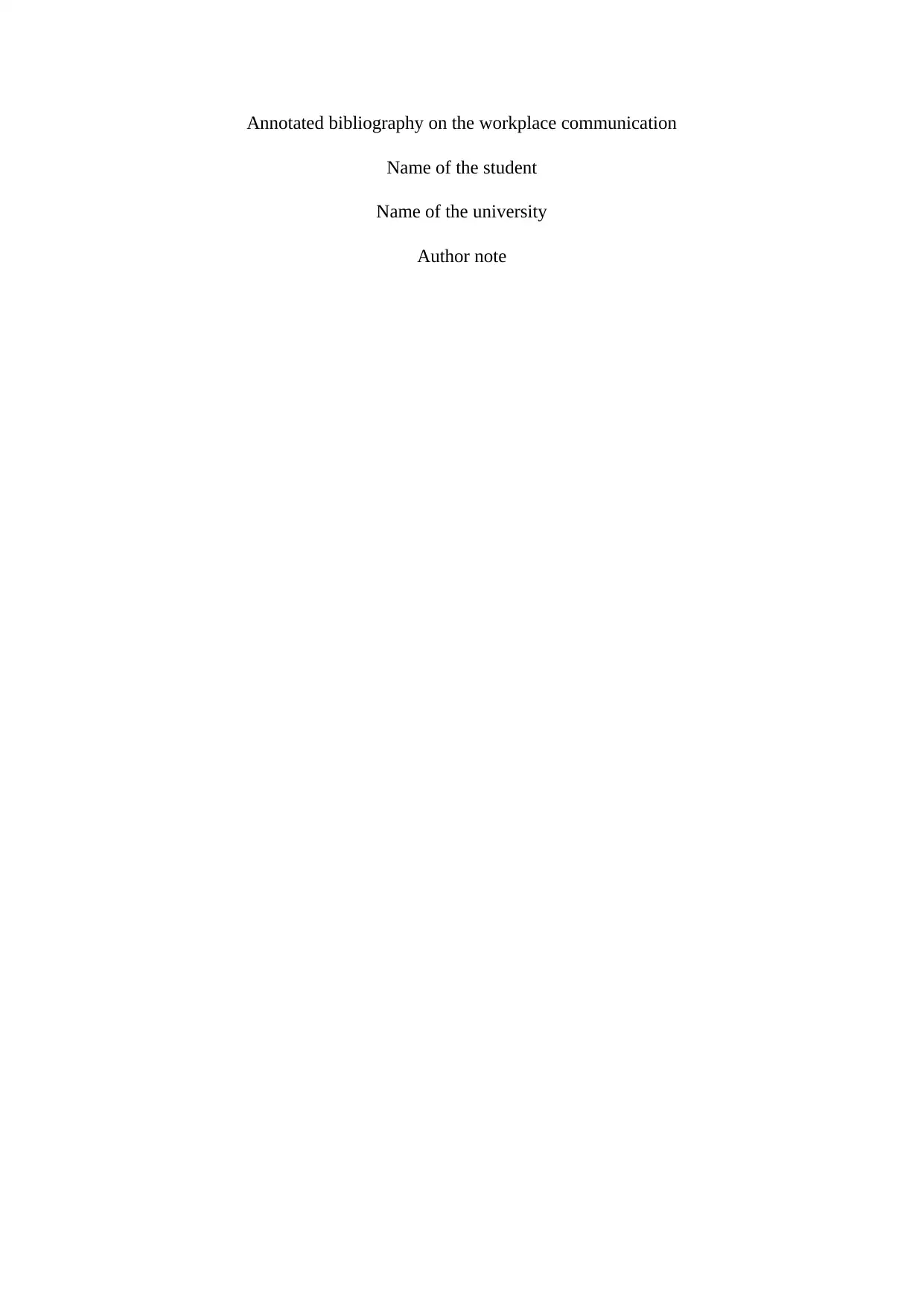
Annotated bibliography on the workplace communication
Name of the student
Name of the university
Author note
Name of the student
Name of the university
Author note
Paraphrase This Document
Need a fresh take? Get an instant paraphrase of this document with our AI Paraphraser
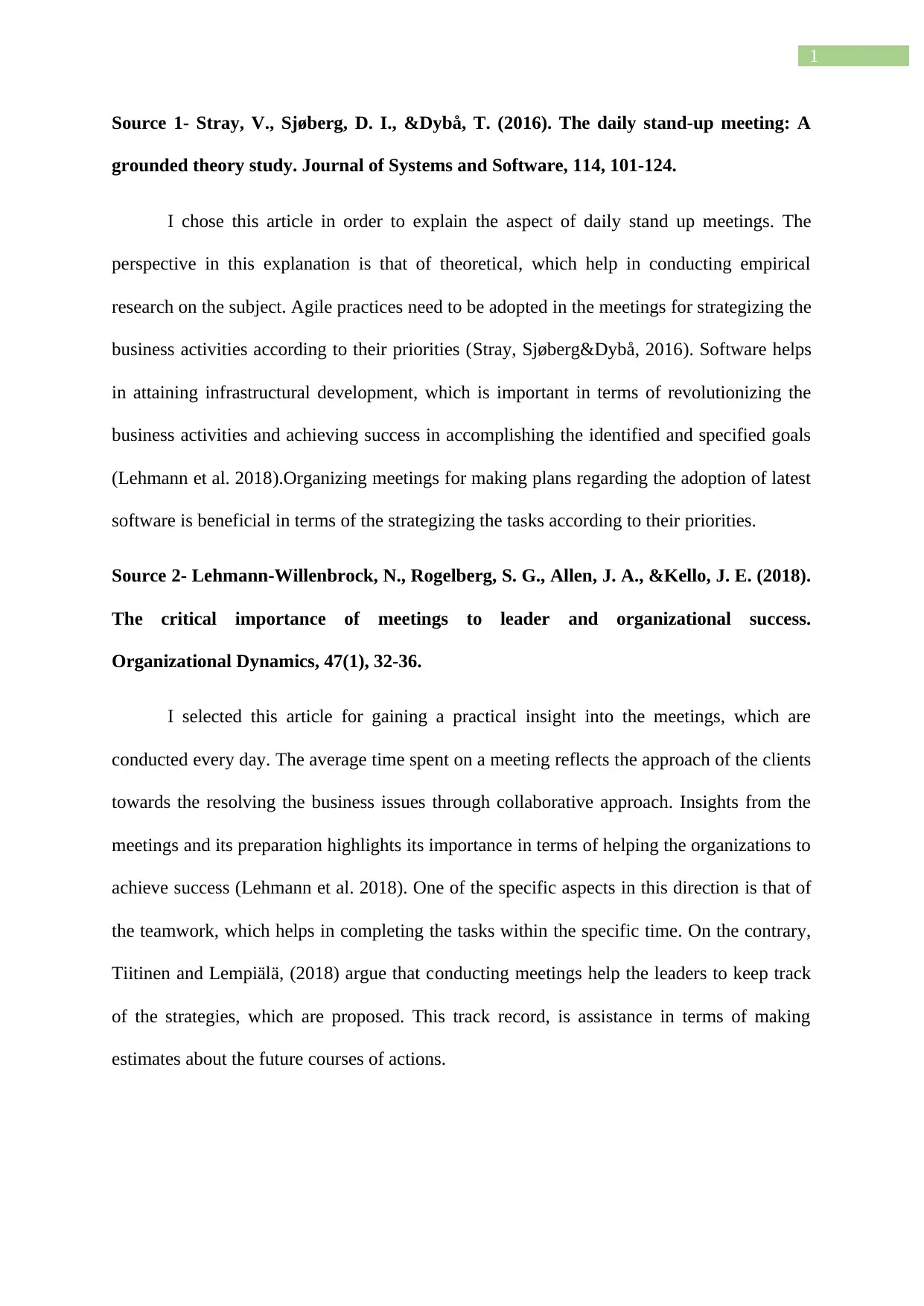
1
Source 1- Stray, V., Sjøberg, D. I., &Dybå, T. (2016). The daily stand-up meeting: A
grounded theory study. Journal of Systems and Software, 114, 101-124.
I chose this article in order to explain the aspect of daily stand up meetings. The
perspective in this explanation is that of theoretical, which help in conducting empirical
research on the subject. Agile practices need to be adopted in the meetings for strategizing the
business activities according to their priorities (Stray, Sjøberg&Dybå, 2016). Software helps
in attaining infrastructural development, which is important in terms of revolutionizing the
business activities and achieving success in accomplishing the identified and specified goals
(Lehmann et al. 2018).Organizing meetings for making plans regarding the adoption of latest
software is beneficial in terms of the strategizing the tasks according to their priorities.
Source 2- Lehmann-Willenbrock, N., Rogelberg, S. G., Allen, J. A., &Kello, J. E. (2018).
The critical importance of meetings to leader and organizational success.
Organizational Dynamics, 47(1), 32-36.
I selected this article for gaining a practical insight into the meetings, which are
conducted every day. The average time spent on a meeting reflects the approach of the clients
towards the resolving the business issues through collaborative approach. Insights from the
meetings and its preparation highlights its importance in terms of helping the organizations to
achieve success (Lehmann et al. 2018). One of the specific aspects in this direction is that of
the teamwork, which helps in completing the tasks within the specific time. On the contrary,
Tiitinen and Lempiälä, (2018) argue that conducting meetings help the leaders to keep track
of the strategies, which are proposed. This track record, is assistance in terms of making
estimates about the future courses of actions.
Source 1- Stray, V., Sjøberg, D. I., &Dybå, T. (2016). The daily stand-up meeting: A
grounded theory study. Journal of Systems and Software, 114, 101-124.
I chose this article in order to explain the aspect of daily stand up meetings. The
perspective in this explanation is that of theoretical, which help in conducting empirical
research on the subject. Agile practices need to be adopted in the meetings for strategizing the
business activities according to their priorities (Stray, Sjøberg&Dybå, 2016). Software helps
in attaining infrastructural development, which is important in terms of revolutionizing the
business activities and achieving success in accomplishing the identified and specified goals
(Lehmann et al. 2018).Organizing meetings for making plans regarding the adoption of latest
software is beneficial in terms of the strategizing the tasks according to their priorities.
Source 2- Lehmann-Willenbrock, N., Rogelberg, S. G., Allen, J. A., &Kello, J. E. (2018).
The critical importance of meetings to leader and organizational success.
Organizational Dynamics, 47(1), 32-36.
I selected this article for gaining a practical insight into the meetings, which are
conducted every day. The average time spent on a meeting reflects the approach of the clients
towards the resolving the business issues through collaborative approach. Insights from the
meetings and its preparation highlights its importance in terms of helping the organizations to
achieve success (Lehmann et al. 2018). One of the specific aspects in this direction is that of
the teamwork, which helps in completing the tasks within the specific time. On the contrary,
Tiitinen and Lempiälä, (2018) argue that conducting meetings help the leaders to keep track
of the strategies, which are proposed. This track record, is assistance in terms of making
estimates about the future courses of actions.
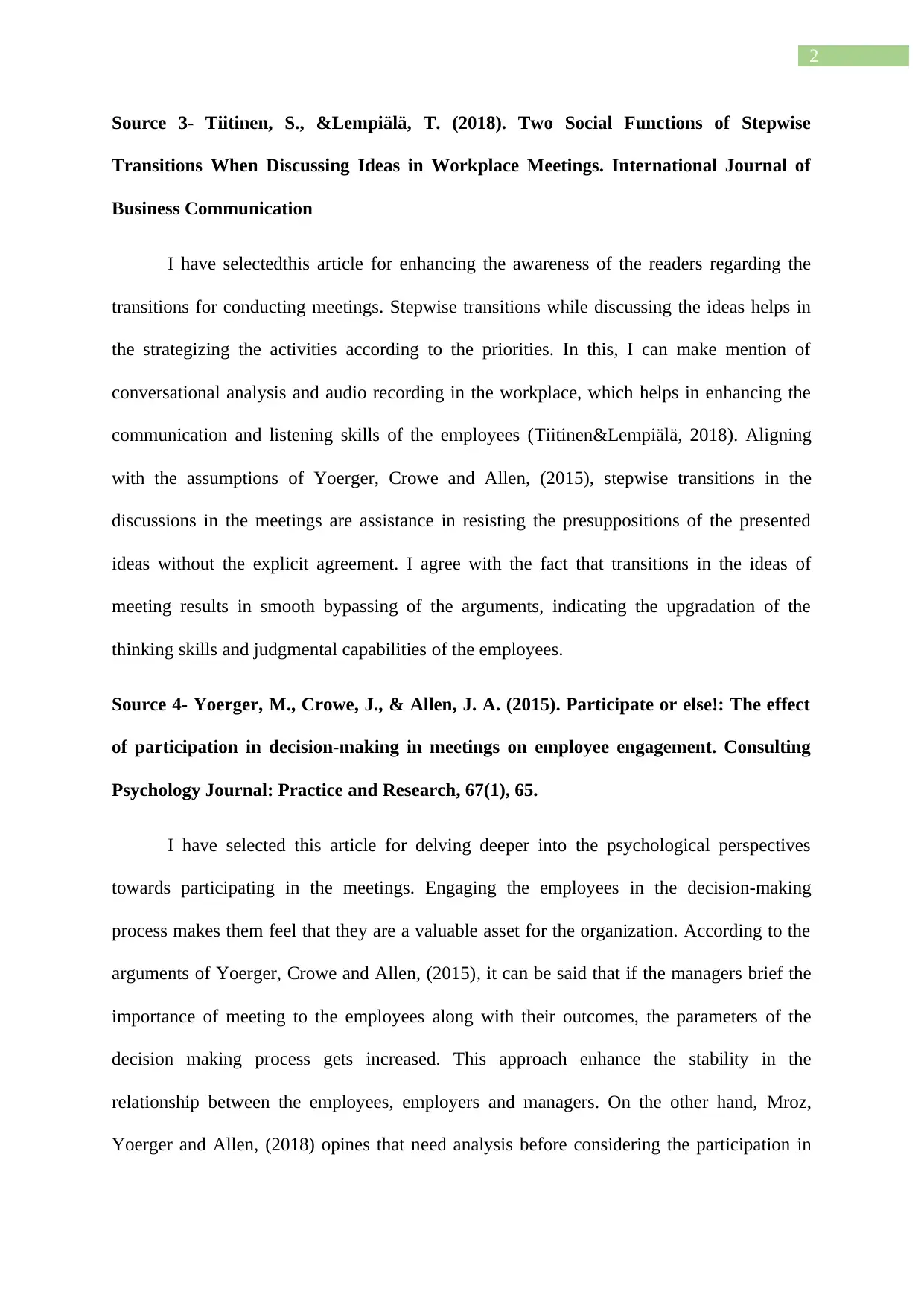
2
Source 3- Tiitinen, S., &Lempiälä, T. (2018). Two Social Functions of Stepwise
Transitions When Discussing Ideas in Workplace Meetings. International Journal of
Business Communication
I have selectedthis article for enhancing the awareness of the readers regarding the
transitions for conducting meetings. Stepwise transitions while discussing the ideas helps in
the strategizing the activities according to the priorities. In this, I can make mention of
conversational analysis and audio recording in the workplace, which helps in enhancing the
communication and listening skills of the employees (Tiitinen&Lempiälä, 2018). Aligning
with the assumptions of Yoerger, Crowe and Allen, (2015), stepwise transitions in the
discussions in the meetings are assistance in resisting the presuppositions of the presented
ideas without the explicit agreement. I agree with the fact that transitions in the ideas of
meeting results in smooth bypassing of the arguments, indicating the upgradation of the
thinking skills and judgmental capabilities of the employees.
Source 4- Yoerger, M., Crowe, J., & Allen, J. A. (2015). Participate or else!: The effect
of participation in decision-making in meetings on employee engagement. Consulting
Psychology Journal: Practice and Research, 67(1), 65.
I have selected this article for delving deeper into the psychological perspectives
towards participating in the meetings. Engaging the employees in the decision-making
process makes them feel that they are a valuable asset for the organization. According to the
arguments of Yoerger, Crowe and Allen, (2015), it can be said that if the managers brief the
importance of meeting to the employees along with their outcomes, the parameters of the
decision making process gets increased. This approach enhance the stability in the
relationship between the employees, employers and managers. On the other hand, Mroz,
Yoerger and Allen, (2018) opines that need analysis before considering the participation in
Source 3- Tiitinen, S., &Lempiälä, T. (2018). Two Social Functions of Stepwise
Transitions When Discussing Ideas in Workplace Meetings. International Journal of
Business Communication
I have selectedthis article for enhancing the awareness of the readers regarding the
transitions for conducting meetings. Stepwise transitions while discussing the ideas helps in
the strategizing the activities according to the priorities. In this, I can make mention of
conversational analysis and audio recording in the workplace, which helps in enhancing the
communication and listening skills of the employees (Tiitinen&Lempiälä, 2018). Aligning
with the assumptions of Yoerger, Crowe and Allen, (2015), stepwise transitions in the
discussions in the meetings are assistance in resisting the presuppositions of the presented
ideas without the explicit agreement. I agree with the fact that transitions in the ideas of
meeting results in smooth bypassing of the arguments, indicating the upgradation of the
thinking skills and judgmental capabilities of the employees.
Source 4- Yoerger, M., Crowe, J., & Allen, J. A. (2015). Participate or else!: The effect
of participation in decision-making in meetings on employee engagement. Consulting
Psychology Journal: Practice and Research, 67(1), 65.
I have selected this article for delving deeper into the psychological perspectives
towards participating in the meetings. Engaging the employees in the decision-making
process makes them feel that they are a valuable asset for the organization. According to the
arguments of Yoerger, Crowe and Allen, (2015), it can be said that if the managers brief the
importance of meeting to the employees along with their outcomes, the parameters of the
decision making process gets increased. This approach enhance the stability in the
relationship between the employees, employers and managers. On the other hand, Mroz,
Yoerger and Allen, (2018) opines that need analysis before considering the participation in
⊘ This is a preview!⊘
Do you want full access?
Subscribe today to unlock all pages.

Trusted by 1+ million students worldwide
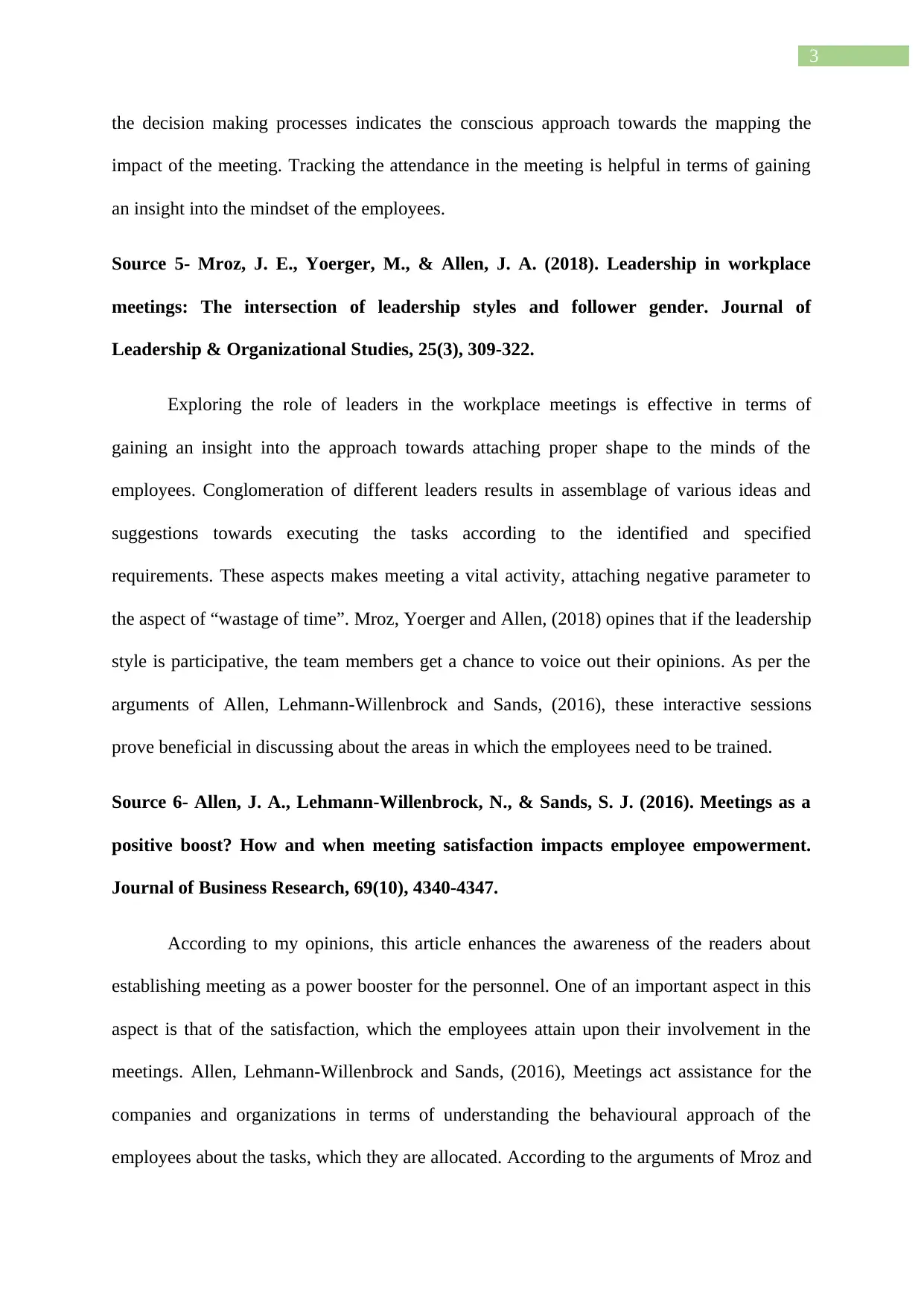
3
the decision making processes indicates the conscious approach towards the mapping the
impact of the meeting. Tracking the attendance in the meeting is helpful in terms of gaining
an insight into the mindset of the employees.
Source 5- Mroz, J. E., Yoerger, M., & Allen, J. A. (2018). Leadership in workplace
meetings: The intersection of leadership styles and follower gender. Journal of
Leadership & Organizational Studies, 25(3), 309-322.
Exploring the role of leaders in the workplace meetings is effective in terms of
gaining an insight into the approach towards attaching proper shape to the minds of the
employees. Conglomeration of different leaders results in assemblage of various ideas and
suggestions towards executing the tasks according to the identified and specified
requirements. These aspects makes meeting a vital activity, attaching negative parameter to
the aspect of “wastage of time”. Mroz, Yoerger and Allen, (2018) opines that if the leadership
style is participative, the team members get a chance to voice out their opinions. As per the
arguments of Allen, Lehmann-Willenbrock and Sands, (2016), these interactive sessions
prove beneficial in discussing about the areas in which the employees need to be trained.
Source 6- Allen, J. A., Lehmann-Willenbrock, N., & Sands, S. J. (2016). Meetings as a
positive boost? How and when meeting satisfaction impacts employee empowerment.
Journal of Business Research, 69(10), 4340-4347.
According to my opinions, this article enhances the awareness of the readers about
establishing meeting as a power booster for the personnel. One of an important aspect in this
aspect is that of the satisfaction, which the employees attain upon their involvement in the
meetings. Allen, Lehmann-Willenbrock and Sands, (2016), Meetings act assistance for the
companies and organizations in terms of understanding the behavioural approach of the
employees about the tasks, which they are allocated. According to the arguments of Mroz and
the decision making processes indicates the conscious approach towards the mapping the
impact of the meeting. Tracking the attendance in the meeting is helpful in terms of gaining
an insight into the mindset of the employees.
Source 5- Mroz, J. E., Yoerger, M., & Allen, J. A. (2018). Leadership in workplace
meetings: The intersection of leadership styles and follower gender. Journal of
Leadership & Organizational Studies, 25(3), 309-322.
Exploring the role of leaders in the workplace meetings is effective in terms of
gaining an insight into the approach towards attaching proper shape to the minds of the
employees. Conglomeration of different leaders results in assemblage of various ideas and
suggestions towards executing the tasks according to the identified and specified
requirements. These aspects makes meeting a vital activity, attaching negative parameter to
the aspect of “wastage of time”. Mroz, Yoerger and Allen, (2018) opines that if the leadership
style is participative, the team members get a chance to voice out their opinions. As per the
arguments of Allen, Lehmann-Willenbrock and Sands, (2016), these interactive sessions
prove beneficial in discussing about the areas in which the employees need to be trained.
Source 6- Allen, J. A., Lehmann-Willenbrock, N., & Sands, S. J. (2016). Meetings as a
positive boost? How and when meeting satisfaction impacts employee empowerment.
Journal of Business Research, 69(10), 4340-4347.
According to my opinions, this article enhances the awareness of the readers about
establishing meeting as a power booster for the personnel. One of an important aspect in this
aspect is that of the satisfaction, which the employees attain upon their involvement in the
meetings. Allen, Lehmann-Willenbrock and Sands, (2016), Meetings act assistance for the
companies and organizations in terms of understanding the behavioural approach of the
employees about the tasks, which they are allocated. According to the arguments of Mroz and
Paraphrase This Document
Need a fresh take? Get an instant paraphrase of this document with our AI Paraphraser
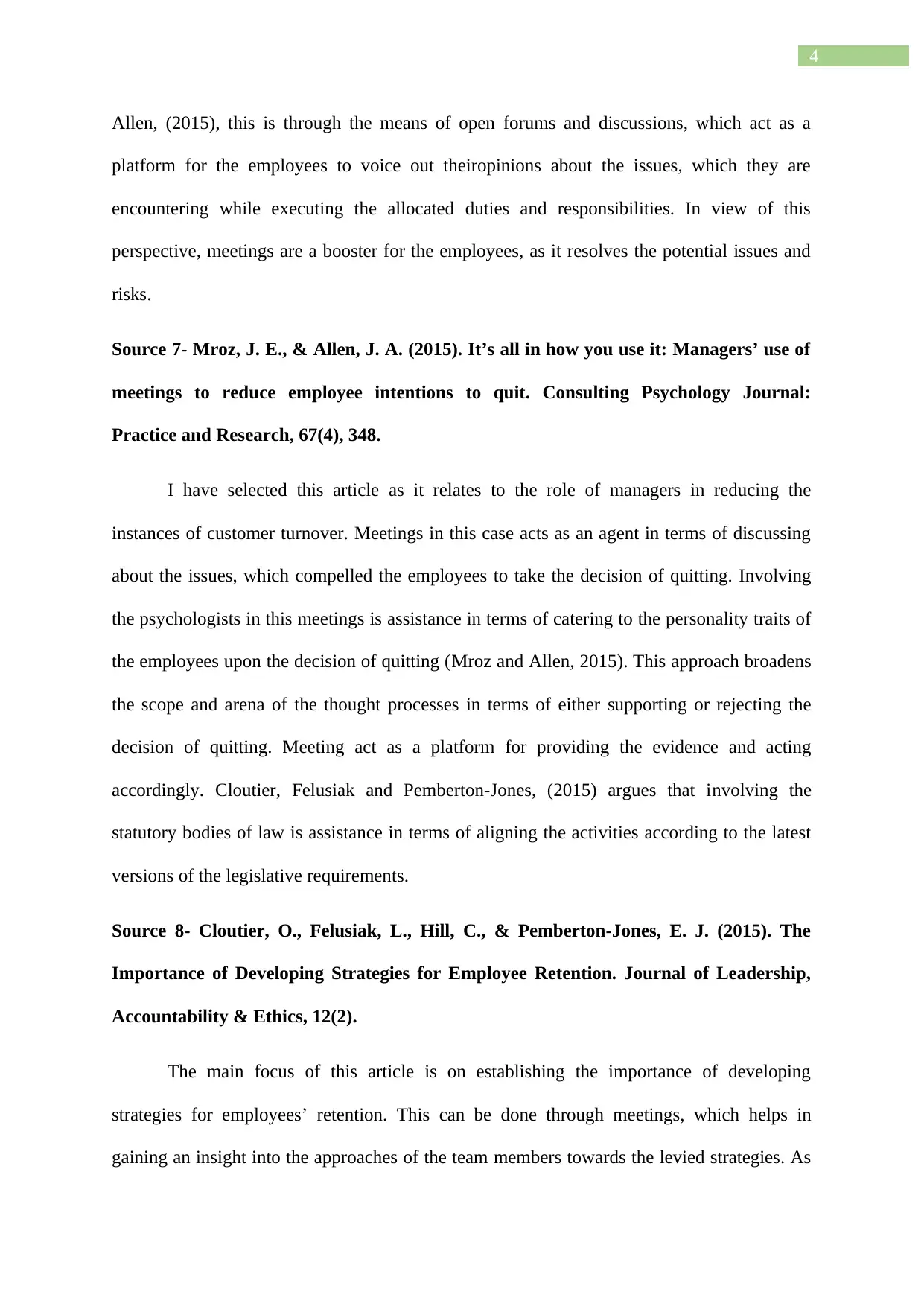
4
Allen, (2015), this is through the means of open forums and discussions, which act as a
platform for the employees to voice out theiropinions about the issues, which they are
encountering while executing the allocated duties and responsibilities. In view of this
perspective, meetings are a booster for the employees, as it resolves the potential issues and
risks.
Source 7- Mroz, J. E., & Allen, J. A. (2015). It’s all in how you use it: Managers’ use of
meetings to reduce employee intentions to quit. Consulting Psychology Journal:
Practice and Research, 67(4), 348.
I have selected this article as it relates to the role of managers in reducing the
instances of customer turnover. Meetings in this case acts as an agent in terms of discussing
about the issues, which compelled the employees to take the decision of quitting. Involving
the psychologists in this meetings is assistance in terms of catering to the personality traits of
the employees upon the decision of quitting (Mroz and Allen, 2015). This approach broadens
the scope and arena of the thought processes in terms of either supporting or rejecting the
decision of quitting. Meeting act as a platform for providing the evidence and acting
accordingly. Cloutier, Felusiak and Pemberton-Jones, (2015) argues that involving the
statutory bodies of law is assistance in terms of aligning the activities according to the latest
versions of the legislative requirements.
Source 8- Cloutier, O., Felusiak, L., Hill, C., & Pemberton-Jones, E. J. (2015). The
Importance of Developing Strategies for Employee Retention. Journal of Leadership,
Accountability & Ethics, 12(2).
The main focus of this article is on establishing the importance of developing
strategies for employees’ retention. This can be done through meetings, which helps in
gaining an insight into the approaches of the team members towards the levied strategies. As
Allen, (2015), this is through the means of open forums and discussions, which act as a
platform for the employees to voice out theiropinions about the issues, which they are
encountering while executing the allocated duties and responsibilities. In view of this
perspective, meetings are a booster for the employees, as it resolves the potential issues and
risks.
Source 7- Mroz, J. E., & Allen, J. A. (2015). It’s all in how you use it: Managers’ use of
meetings to reduce employee intentions to quit. Consulting Psychology Journal:
Practice and Research, 67(4), 348.
I have selected this article as it relates to the role of managers in reducing the
instances of customer turnover. Meetings in this case acts as an agent in terms of discussing
about the issues, which compelled the employees to take the decision of quitting. Involving
the psychologists in this meetings is assistance in terms of catering to the personality traits of
the employees upon the decision of quitting (Mroz and Allen, 2015). This approach broadens
the scope and arena of the thought processes in terms of either supporting or rejecting the
decision of quitting. Meeting act as a platform for providing the evidence and acting
accordingly. Cloutier, Felusiak and Pemberton-Jones, (2015) argues that involving the
statutory bodies of law is assistance in terms of aligning the activities according to the latest
versions of the legislative requirements.
Source 8- Cloutier, O., Felusiak, L., Hill, C., & Pemberton-Jones, E. J. (2015). The
Importance of Developing Strategies for Employee Retention. Journal of Leadership,
Accountability & Ethics, 12(2).
The main focus of this article is on establishing the importance of developing
strategies for employees’ retention. This can be done through meetings, which helps in
gaining an insight into the approaches of the team members towards the levied strategies. As
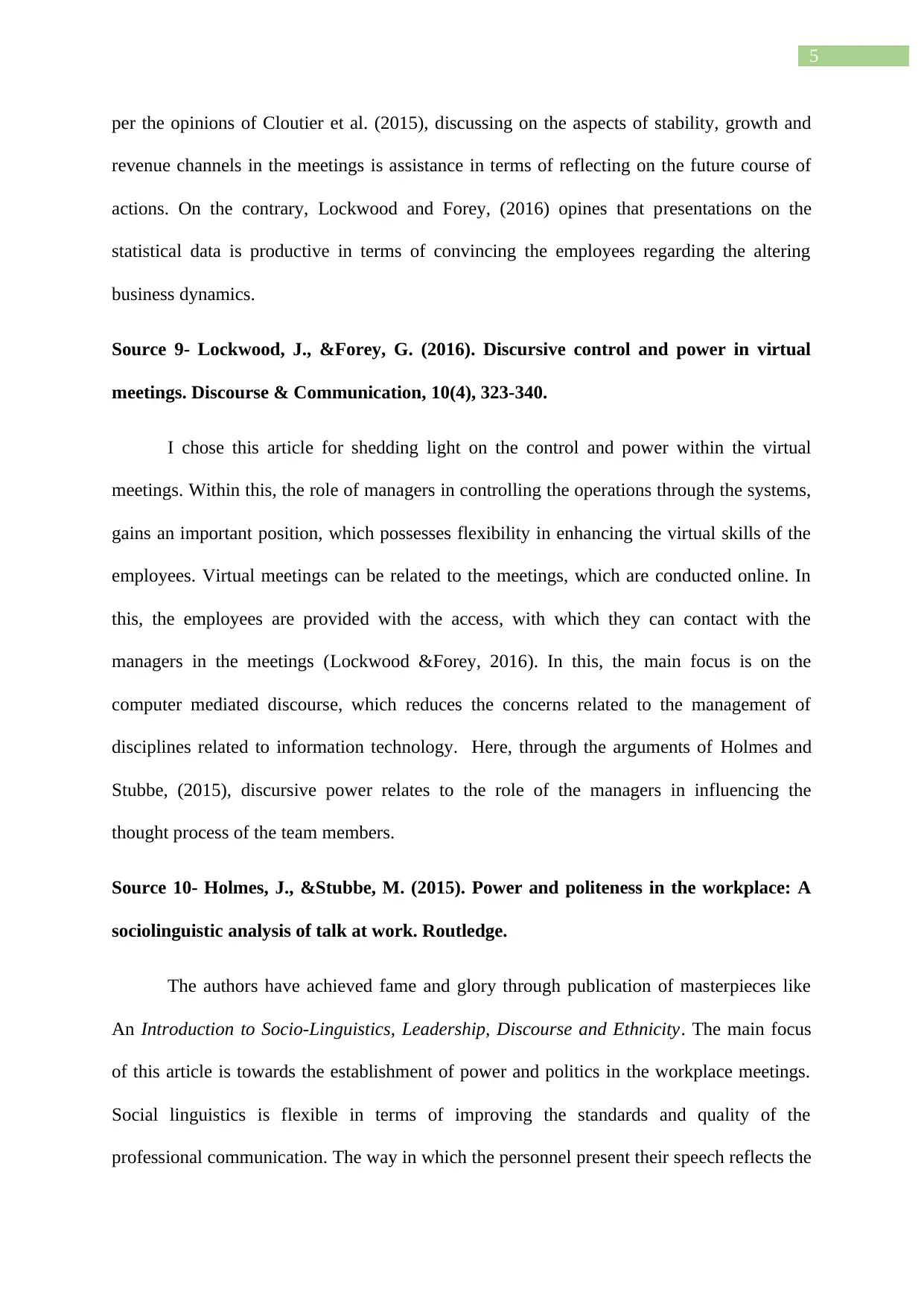
5
per the opinions of Cloutier et al. (2015), discussing on the aspects of stability, growth and
revenue channels in the meetings is assistance in terms of reflecting on the future course of
actions. On the contrary, Lockwood and Forey, (2016) opines that presentations on the
statistical data is productive in terms of convincing the employees regarding the altering
business dynamics.
Source 9- Lockwood, J., &Forey, G. (2016). Discursive control and power in virtual
meetings. Discourse & Communication, 10(4), 323-340.
I chose this article for shedding light on the control and power within the virtual
meetings. Within this, the role of managers in controlling the operations through the systems,
gains an important position, which possesses flexibility in enhancing the virtual skills of the
employees. Virtual meetings can be related to the meetings, which are conducted online. In
this, the employees are provided with the access, with which they can contact with the
managers in the meetings (Lockwood &Forey, 2016). In this, the main focus is on the
computer mediated discourse, which reduces the concerns related to the management of
disciplines related to information technology. Here, through the arguments of Holmes and
Stubbe, (2015), discursive power relates to the role of the managers in influencing the
thought process of the team members.
Source 10- Holmes, J., &Stubbe, M. (2015). Power and politeness in the workplace: A
sociolinguistic analysis of talk at work. Routledge.
The authors have achieved fame and glory through publication of masterpieces like
An Introduction to Socio-Linguistics, Leadership, Discourse and Ethnicity. The main focus
of this article is towards the establishment of power and politics in the workplace meetings.
Social linguistics is flexible in terms of improving the standards and quality of the
professional communication. The way in which the personnel present their speech reflects the
per the opinions of Cloutier et al. (2015), discussing on the aspects of stability, growth and
revenue channels in the meetings is assistance in terms of reflecting on the future course of
actions. On the contrary, Lockwood and Forey, (2016) opines that presentations on the
statistical data is productive in terms of convincing the employees regarding the altering
business dynamics.
Source 9- Lockwood, J., &Forey, G. (2016). Discursive control and power in virtual
meetings. Discourse & Communication, 10(4), 323-340.
I chose this article for shedding light on the control and power within the virtual
meetings. Within this, the role of managers in controlling the operations through the systems,
gains an important position, which possesses flexibility in enhancing the virtual skills of the
employees. Virtual meetings can be related to the meetings, which are conducted online. In
this, the employees are provided with the access, with which they can contact with the
managers in the meetings (Lockwood &Forey, 2016). In this, the main focus is on the
computer mediated discourse, which reduces the concerns related to the management of
disciplines related to information technology. Here, through the arguments of Holmes and
Stubbe, (2015), discursive power relates to the role of the managers in influencing the
thought process of the team members.
Source 10- Holmes, J., &Stubbe, M. (2015). Power and politeness in the workplace: A
sociolinguistic analysis of talk at work. Routledge.
The authors have achieved fame and glory through publication of masterpieces like
An Introduction to Socio-Linguistics, Leadership, Discourse and Ethnicity. The main focus
of this article is towards the establishment of power and politics in the workplace meetings.
Social linguistics is flexible in terms of improving the standards and quality of the
professional communication. The way in which the personnel present their speech reflects the
⊘ This is a preview!⊘
Do you want full access?
Subscribe today to unlock all pages.

Trusted by 1+ million students worldwide
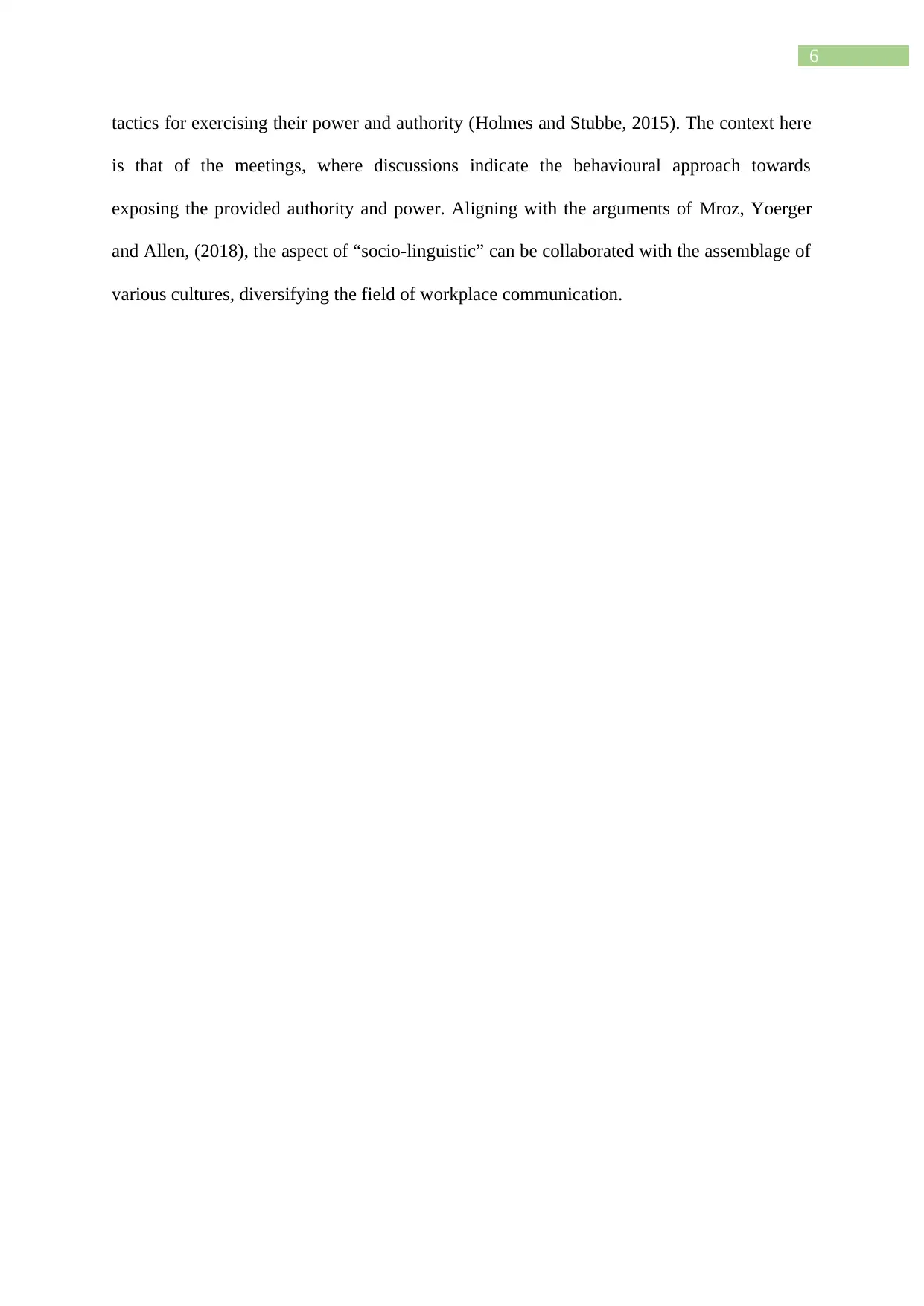
6
tactics for exercising their power and authority (Holmes and Stubbe, 2015). The context here
is that of the meetings, where discussions indicate the behavioural approach towards
exposing the provided authority and power. Aligning with the arguments of Mroz, Yoerger
and Allen, (2018), the aspect of “socio-linguistic” can be collaborated with the assemblage of
various cultures, diversifying the field of workplace communication.
tactics for exercising their power and authority (Holmes and Stubbe, 2015). The context here
is that of the meetings, where discussions indicate the behavioural approach towards
exposing the provided authority and power. Aligning with the arguments of Mroz, Yoerger
and Allen, (2018), the aspect of “socio-linguistic” can be collaborated with the assemblage of
various cultures, diversifying the field of workplace communication.
Paraphrase This Document
Need a fresh take? Get an instant paraphrase of this document with our AI Paraphraser
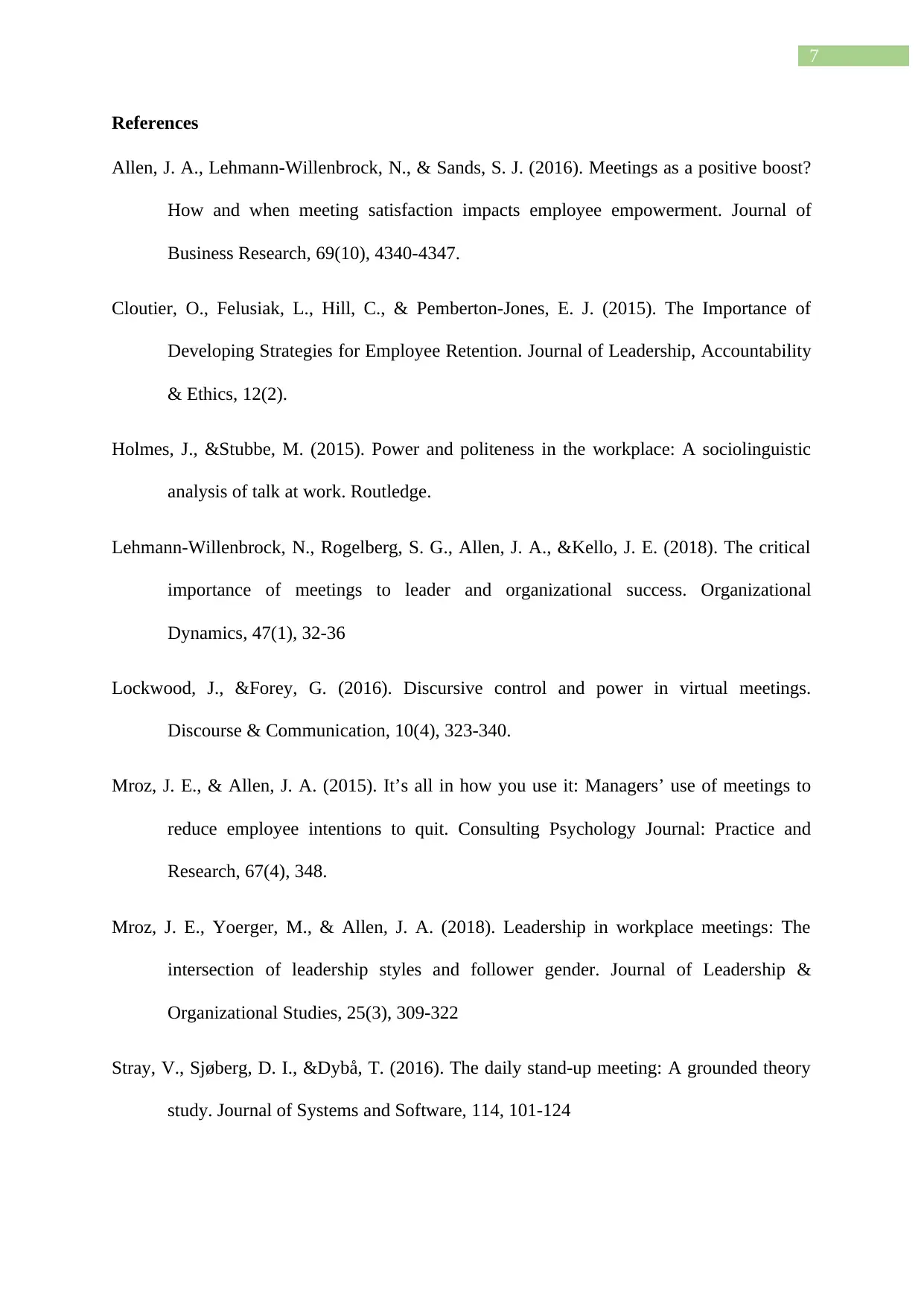
7
References
Allen, J. A., Lehmann-Willenbrock, N., & Sands, S. J. (2016). Meetings as a positive boost?
How and when meeting satisfaction impacts employee empowerment. Journal of
Business Research, 69(10), 4340-4347.
Cloutier, O., Felusiak, L., Hill, C., & Pemberton-Jones, E. J. (2015). The Importance of
Developing Strategies for Employee Retention. Journal of Leadership, Accountability
& Ethics, 12(2).
Holmes, J., &Stubbe, M. (2015). Power and politeness in the workplace: A sociolinguistic
analysis of talk at work. Routledge.
Lehmann-Willenbrock, N., Rogelberg, S. G., Allen, J. A., &Kello, J. E. (2018). The critical
importance of meetings to leader and organizational success. Organizational
Dynamics, 47(1), 32-36
Lockwood, J., &Forey, G. (2016). Discursive control and power in virtual meetings.
Discourse & Communication, 10(4), 323-340.
Mroz, J. E., & Allen, J. A. (2015). It’s all in how you use it: Managers’ use of meetings to
reduce employee intentions to quit. Consulting Psychology Journal: Practice and
Research, 67(4), 348.
Mroz, J. E., Yoerger, M., & Allen, J. A. (2018). Leadership in workplace meetings: The
intersection of leadership styles and follower gender. Journal of Leadership &
Organizational Studies, 25(3), 309-322
Stray, V., Sjøberg, D. I., &Dybå, T. (2016). The daily stand-up meeting: A grounded theory
study. Journal of Systems and Software, 114, 101-124
References
Allen, J. A., Lehmann-Willenbrock, N., & Sands, S. J. (2016). Meetings as a positive boost?
How and when meeting satisfaction impacts employee empowerment. Journal of
Business Research, 69(10), 4340-4347.
Cloutier, O., Felusiak, L., Hill, C., & Pemberton-Jones, E. J. (2015). The Importance of
Developing Strategies for Employee Retention. Journal of Leadership, Accountability
& Ethics, 12(2).
Holmes, J., &Stubbe, M. (2015). Power and politeness in the workplace: A sociolinguistic
analysis of talk at work. Routledge.
Lehmann-Willenbrock, N., Rogelberg, S. G., Allen, J. A., &Kello, J. E. (2018). The critical
importance of meetings to leader and organizational success. Organizational
Dynamics, 47(1), 32-36
Lockwood, J., &Forey, G. (2016). Discursive control and power in virtual meetings.
Discourse & Communication, 10(4), 323-340.
Mroz, J. E., & Allen, J. A. (2015). It’s all in how you use it: Managers’ use of meetings to
reduce employee intentions to quit. Consulting Psychology Journal: Practice and
Research, 67(4), 348.
Mroz, J. E., Yoerger, M., & Allen, J. A. (2018). Leadership in workplace meetings: The
intersection of leadership styles and follower gender. Journal of Leadership &
Organizational Studies, 25(3), 309-322
Stray, V., Sjøberg, D. I., &Dybå, T. (2016). The daily stand-up meeting: A grounded theory
study. Journal of Systems and Software, 114, 101-124

8
Tiitinen, S., &Lempiälä, T. (2018). Two Social Functions of Stepwise Transitions When
Discussing Ideas in Workplace Meetings. International Journal of Business
Communication
Yoerger, M., Crowe, J., & Allen, J. A. (2015). Participate or else!: The effect of participation
in decision-making in meetings on employee engagement. Consulting Psychology
Journal: Practice and Research, 67(1), 65
Tiitinen, S., &Lempiälä, T. (2018). Two Social Functions of Stepwise Transitions When
Discussing Ideas in Workplace Meetings. International Journal of Business
Communication
Yoerger, M., Crowe, J., & Allen, J. A. (2015). Participate or else!: The effect of participation
in decision-making in meetings on employee engagement. Consulting Psychology
Journal: Practice and Research, 67(1), 65
⊘ This is a preview!⊘
Do you want full access?
Subscribe today to unlock all pages.

Trusted by 1+ million students worldwide
1 out of 9
Your All-in-One AI-Powered Toolkit for Academic Success.
+13062052269
info@desklib.com
Available 24*7 on WhatsApp / Email
![[object Object]](/_next/static/media/star-bottom.7253800d.svg)
Unlock your academic potential
Copyright © 2020–2025 A2Z Services. All Rights Reserved. Developed and managed by ZUCOL.
